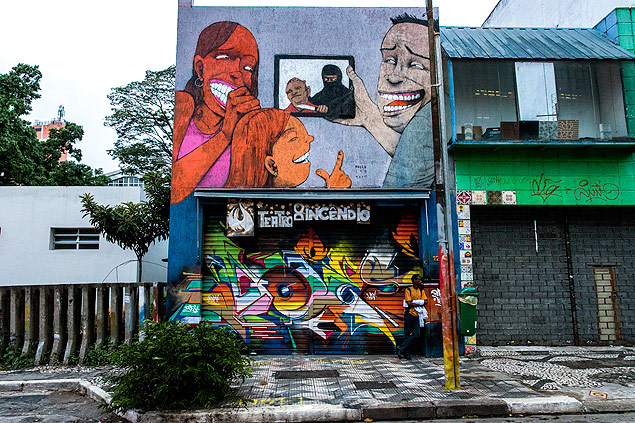Latest Photo Galleries
Brazilian Markets
17h34 Bovespa |
-0,32% | 124.741 |
16h43 Gold |
0,00% | 117 |
17h00 Dollar |
+0,38% | 5,1487 |
16h30 Euro |
+0,49% | 2,65250 |
ADVERTISING
São Paulo Graffiti Shows People Laughing at Isis Atrocities
03/02/2015 - 10h07
Advertising
FROM SÃO PAULO
A painting of three people laughing as they see a man about to be executed by a member of the Islamic State (Isis) has been raising eyebrows amongst passers-by on the Rua da Consolação, one of São Paulo's busiest streets.
The 5x5m work was painted by street artist Paulo Ito on the front of the Teatro do Incêndio theater, at the company's request.
"It was a partnership with the artist, and we gave him total liberty to express his vision of the banalization of violence", says Marcelo Fonseca, the theater's artistic director.
When contacted by Folha, Ito said that the main theme of the picture is people's reactions to the atrocities being committed by Isis, rather than the atrocities themselves.
"The Isis scene informs the theme rather than being the theme itself. This is the reading some people have of the painting. The theme is the banalization of violence", he said.
Since completing the painting, on February 16, Ito has been accused of "excusing violence", a charge he rejects.
"They accuse me of excusing violence. If I wanted to excuse violence, I would do something that is actually violent", he said. "People are scared, and they project that fear onto the work of others."
HARMONY
For Fonseca, Ito's work is "in harmony" with the theater's project of combating violence and intolerance.
"What's so striking about the picture is that people are laughing about something so serious", he says. "I think that this, to a certain extent, is a portrait of the world."
The Teatro do Incêndio has been running for 20 years, though it only moved to its current location on Rua da Consolação in 2014.
Fonseca argues that art has the "advantage" of provoking in this manner.
"We can't stop people from having their own interpretations", he says. "Within the aesthetic experience, they place themselves where they prefer: inside or outside of the image."
He says he does not fear a negative reaction from the public, and is not considering changing the work. "I can't touch the artist's work. If I really thought that it might do some bad, like inciting something, I would ask him to change it."
This month, Isis published a video showing its militants decapitating 21 Egyptian Christians in Libya. Prior to that, the group had posted videos showing the executions of at least eight foreign hostages, one of whom, the Jordanian pilot Maaz al-Kasasheh, was burnt alive.
Translated by TOM GATEHOUSE
Read the article in the original language
| Adriano Vizoni/Folhapress | ||
 |
||
| Since completing the painting, Ito has been accused of "excusing violence", a charge he rejects |



